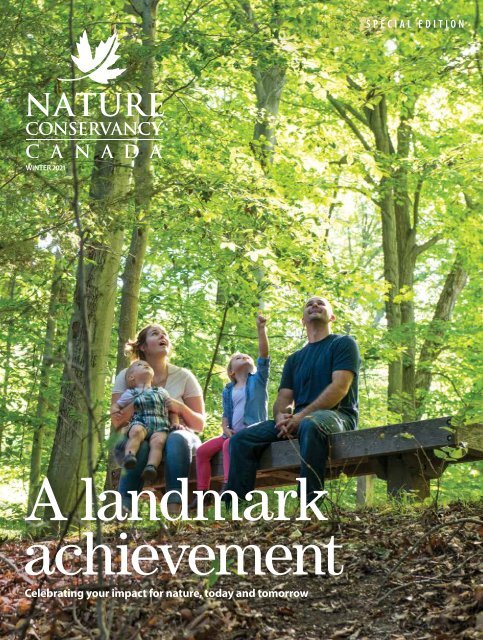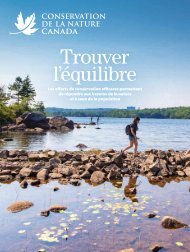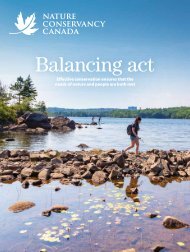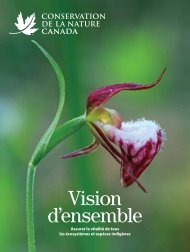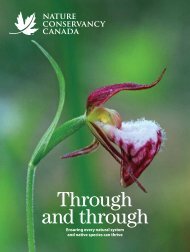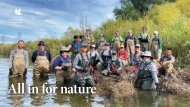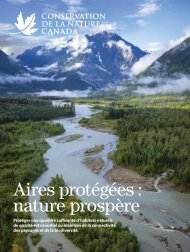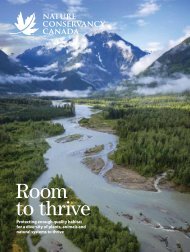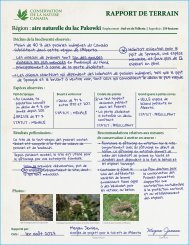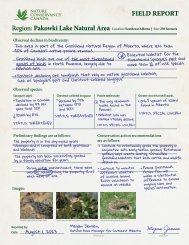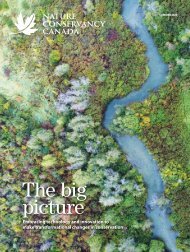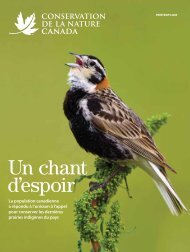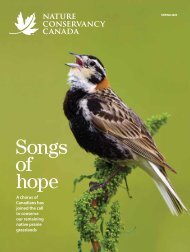Winter 2021 Magazine
You also want an ePaper? Increase the reach of your titles
YUMPU automatically turns print PDFs into web optimized ePapers that Google loves.
SPECIAL EDITION<br />
WINTER <strong>2021</strong><br />
A landmark<br />
achievement<br />
Celebrating your impact for nature, today and tomorrow
*<br />
Conserve, connect<br />
and inspire<br />
W<br />
e all need good news in the midst of challenging<br />
times. That’s why I’m so pleased to be able to<br />
celebrate with you the success of the Nature<br />
Conservancy of Canada’s (NCC’s) Landmark Campaign. The<br />
campaign was designed to conserve our country’s precious<br />
natural areas and the wildlife that depend on them, connect<br />
more Canadians than ever before to our country’s natural<br />
landscapes and inspire the next generation of conservation<br />
leaders. As you’ll read in this special issue of the NCC <strong>Magazine</strong>,<br />
not only did we meet these goals, we exceeded them.<br />
Donors from communities across Canada mobilized like never<br />
before to protect nature, and together you donated more<br />
than $750 million dollars.<br />
As Canadians, we are fortunate to have been given an<br />
incredible gift: the unparalleled majesty of nature in this<br />
country, the wildlife that lives in it and the benefits these<br />
places provide to people. Like thousands of you, I believe<br />
it’s our responsibility to conserve these lands, waters and<br />
wildlife, not just for Canadians, but for the rest of the world.<br />
I am truly grateful for the people who have volunteered<br />
their time, including our campaign co-chairs, Hal Kvisle and<br />
Brian Tobin, as well as every one of you who entrusted your<br />
gifts to NCC to help us surpass our campaign goals. Your<br />
commitment inspires us to get our important work done. The<br />
conservation impact of the Landmark Campaign is being felt<br />
right across the country.<br />
As you’ll read in these pages, NCC’s mission is now more<br />
urgent than ever. The next decade is going to be very important<br />
for conservation in Canada. We will need to connect more Canadians<br />
from all walks of life and all backgrounds to our cause.<br />
By continuing to work together, we can build on the foundation<br />
achieved through the amazing Landmark Campaign,<br />
and ensure a sustainable future for Canadians and the world.<br />
Nature Conservancy of Canada<br />
245 Eglinton Ave. East, Suite 410<br />
Toronto, Ontario, Canada M4P 3J1<br />
magazine@natureconservancy.ca<br />
Phone: 416.932.3202<br />
Toll-free: 877.231.3552<br />
The Nature Conservancy of Canada (NCC) is the nation’s<br />
leading land conservation organization, working to protect<br />
our most important natural areas and the species they<br />
sustain. Since 1962, NCC and its partners have helped to<br />
protect 14 million hectares (35 million acres), coast to<br />
coast to coast.<br />
The Nature Conservancy of Canada <strong>Magazine</strong> is distributed to<br />
donors and supporters of NCC.<br />
TM<br />
Trademarks owned by the Nature Conservancy of Canada.<br />
Thank you,<br />
Elana Rosenfeld<br />
Elana Rosenfeld<br />
National Board Chair and National Campaign Cabinet Member<br />
Nature Conservancy of Canada<br />
PS – Want to experience some of the wonderful places you<br />
helped protect? Visit nccnaturescapes.ca for a virtual tour.<br />
FSC is not responsible for any calculations on<br />
saving resources by choosing this paper.<br />
Printed on Supreme Silk paper, which contains 30%<br />
post-consumer fibre, is Processed Chlorine Free certified<br />
and manufactured with Renewable energy. Printed in<br />
Canada with vegetable-based, VOC FREE inks by Warrens<br />
Waterless Printing. This publication saved 25 trees and<br />
88,796 litres of water*.<br />
GENERATED BY: CALCULATEUR.ROLLANDINC.COM.<br />
2 WINTER <strong>2021</strong>
Big Trout Bay, Ontario<br />
TKTKTKTKTKTKT<br />
COVER: NEIL EVER OSBORNE. OPPOSITE PAGE: TAYLOR ROADES. THIS PAGE: COSTAL PRODUCTIONS.<br />
WINTER <strong>2021</strong><br />
CONTENTS<br />
Nature Conservancy of Canada<br />
4 Landmark Campaign impact<br />
Your impact by the numbers.<br />
6 A signature achievement<br />
Thousands of Canadians from coast to coast to coast<br />
took conservation into their own hands and gave to<br />
save the lands and waters that sustain us all.<br />
10 Map: Projects across the country<br />
Together, we mobilized to deliver a historic and lasting<br />
impact for nature and conserved 115,000 square<br />
kilometres with 540 new conservation projects<br />
completed across Canada.<br />
16 Conservation in action<br />
Helping species at risk, the impact of Conservation<br />
Volunteers, and government support.<br />
18 The work has just begun<br />
Past president and CEO, John Lounds, and new president<br />
and CEO, Catherine Grenier, on the accomplishments of<br />
the Landmark Campaign and what’s next.<br />
19 Thank you to our Nature Legacy<br />
Society members<br />
Your legacy gift and passion for nature helped us reach<br />
our Landmark Campaign goals.<br />
natureconservancy.ca<br />
WINTER <strong>2021</strong> 3
Landmark<br />
Campaign<br />
impact<br />
Thank you for supporting the<br />
Nature Conservancy of Canada’s<br />
Landmark Campaign. Together,<br />
we mobilized to deliver a historic<br />
and lasting impact for nature.<br />
Thousands of Canadians, from<br />
coast to coast to coast, took<br />
conservation into their own hands<br />
and gave to save the lands and<br />
waters that sustain us all.<br />
LANDS AND WATERS<br />
Conserved an additional 115,000 square kilometres.<br />
That’s more than 1.5 times the size of New Brunswick.<br />
• Brings NCC total conserved lands to 14 million hectares (35 million acres).<br />
• 540 new conservation projects completed across Canada.<br />
PEOPLE<br />
18,000 volunteers rolled up their sleeves<br />
to care for nature.<br />
Launched the careers of young conservation<br />
leaders, through over 460 internships.<br />
SPECIES<br />
Protected habitat for<br />
130 species at risk<br />
• 10 more threatened than the giant panda.<br />
• 7 found nowhere else in the world.<br />
FINANCIAL<br />
More than $750 million raised<br />
for nature conservation<br />
• 1.1 million donations.<br />
• 110,000 donors.<br />
CONNECTION<br />
More than 300,000 Canadians connected to nature<br />
• 94 per cent of Canadians live within 100 kilometres of a Landmark Campaign project.<br />
• Launched 36 new Nature Destinations, allowing Canadians to benefit physically and<br />
mentally by spending more time in nature.<br />
CLOCKWISE FROMT TOP: KYLE MARQUARDT; BRENT CALVER; MONKEY BUSINESS IMAGES; GORDON MACPHERSON; JOHN E. MARRIOTT.<br />
4 WINTER <strong>2021</strong> natureconservancy.ca
I’ve always found peace in the<br />
beauty of mountains, forests and<br />
water. They remind me of how<br />
lucky we are to live in a country<br />
with such rich natural areas, and<br />
how easy it is to enjoy them, no<br />
matter the time of year.<br />
I realized the need to help protect<br />
Canada’s natural heritage early<br />
on. As in my finance work, where<br />
I must engage in meticulous<br />
analyses, I was careful in selecting<br />
a nature-based organization to<br />
donate to. The Nature Conservancy<br />
of Canada seemed to me the best<br />
choice, due to its unparalleled<br />
mission, its work and its efficiency.<br />
In today’s society, it’s easy to think<br />
that we can’t make a difference.<br />
However, when you can help<br />
someone appreciate a cause that<br />
is close to your heart, it seems<br />
anything is possible. It’s that<br />
lightness, the adrenaline and sense<br />
of accomplishment when the<br />
distance is run that we must keep<br />
in mind every day in our struggle<br />
for a healthier environment.<br />
PAUL ROBERT.<br />
Jean-Michel<br />
Beaulieu<br />
Leader in Conservation and<br />
Nature Legacy Society member<br />
(Quebec)
A signature<br />
achievement<br />
The Nature Conservancy of Canada’s Landmark Campaign has led to a 115,000-squarekilometre<br />
expansion of protected lands and waters, made possible by donations from<br />
110,000 Canadians from all regions and walks of life<br />
BY Brian Banks, award-winning writer and journalist<br />
TKTKTKTKTKTKT<br />
6 WINTER <strong>2021</strong><br />
natureconservancy.ca
Cockburn Island may be the seventhlargest<br />
island in the Great Lakes, but it’s not<br />
exactly a household name. In conservation<br />
circles, however, it’s on everyone’s radar.<br />
Located in northern Lake Huron, west of<br />
Manitoulin Island, the 17,000-hectare (42,000-acre) island<br />
is home to one of the largest intact hardwood forest and<br />
coastal ecosystems in southern Ontario. It provides habitat<br />
for many globally significant plants and animals and is an<br />
important stopover site and breeding area for migratory<br />
songbirds and waterfowl.<br />
That’s why, for nearly a decade, and with the support<br />
of thousands of donors, the Nature Conservancy of Canada<br />
(NCC) has led an international effort to protect it. That<br />
work began in 2012 and, since 2013, continued as a signature<br />
embodiment of the vision of NCC’s national Landmark<br />
Campaign — a just-concluded eight-year drive that raised<br />
in excess of the campaign’s goal of $750 million for conservation,<br />
thanks to 1.1 million donations. This led to the<br />
expansion of NCC’s network of protected lands and waters<br />
by a record-breaking 115,000 square kilometres. There’s<br />
no question; the campaign has been a resounding success.<br />
Along with all of the property protected and money<br />
raised, the third measure of the Landmark Campaign’s<br />
success is the 110,000 donors — Canadians from all regions<br />
and walks of life and beyond — who came together<br />
to save the lands and waters that sustain us all. Perhaps<br />
even more impressive, two thirds of these donors were<br />
inspired to give for the first time, and nearly 100,000 gave<br />
under $1,000, emphasizing that every donation counts.<br />
“NCC listened to Canadians and their vision for a better<br />
world, and turned it into a tangible goal that Canadians<br />
responded to,” says Kyria Knibb-McLuhan, senior director,<br />
campaign and development operations at NCC.<br />
For two of those donors, Jan Oudenes and Isobel<br />
Ralston, Cockburn Island was their entry point into the<br />
campaign. In 2017, the Toronto-area couple sold a successful<br />
business and retired. Ardent paddlers and hikers,<br />
MIKE LAMONT. INSET: NEIL EVER OSBORNE.<br />
Cockburn Island, ON. Inset: Volunteers tree planting, ON.<br />
natureconservancy.ca<br />
WINTER <strong>2021</strong> 7
Waldron Ranch, Alberta<br />
they then decided to commit the next chapter<br />
of their lives and their accumulated<br />
wealth to helping address climate change and<br />
biodiversity loss. To do that, they created<br />
MapleCross, a self-funded enterprise with<br />
a mission to protect Canada’s natural<br />
environment by supporting organizations<br />
that conserve ecologically sensitive land.<br />
“We started talking with NCC and they<br />
mentioned Cockburn Island,” says Ralston.<br />
At the time, in early 2019, NCC was trying to<br />
raise funds to acquire an additional 586-hectare<br />
(1,450-acre) parcel to add to the 60 per cent<br />
of Cockburn Island already secured. Like<br />
most people, Jan and Isobel had never heard<br />
of it. But once they learned of the island’s<br />
ecological value and the protection and stewardship<br />
plan already in place, they funded<br />
the majority of the acquisition of what is now<br />
called the MapleCross Tract.<br />
Since then, MapleCross has been the lead<br />
donor in the purchase of four more properties,<br />
totalling 1,463 hectares (3,614 acres), under<br />
the Landmark Campaign banner. Two of<br />
those are in Ontario, the others are in Quebec<br />
and Saskatchewan.<br />
“We asked NCC to come up with the proposals,”<br />
says Oudenes. “In essence, we asked<br />
them what their priority was in terms of their<br />
science.” Adds Ralston: “We want to invest in<br />
land conservation, not just in our backyard of<br />
Ontario, but across all of Canada. We just want<br />
to make an impact where we feel it is most<br />
needed. NCC provides that national scope.”<br />
“We want to invest in land conservation,<br />
not just in our backyard of Ontario, but<br />
across all of Canada. We just want to make<br />
an impact where we feel it is most needed.”<br />
Jan Oudenes, Landmark Campaign donor<br />
Every donation counts<br />
While not every donor to the Landmark<br />
Campaign had the same means, motivation or<br />
directed outcome, Knibb-McLuhan notes that<br />
all played a similar role, directly or indirectly,<br />
in helping NCC deliver on the campaign’s<br />
three main themes: Conserve, Connect and<br />
Inspire. “Every gift made a difference.”<br />
“Conserve was really all about the bread<br />
and butter of what we do every day, every<br />
week, every year,” Knibb-McLuhan says. “But<br />
the focus was on conserving more, doing it<br />
faster, doing it more efficiently and doing it<br />
better for the best conservation outcomes<br />
possible. And we certainly did that.”<br />
Along with individual donors, other contributors<br />
to the Landmark Campaign included<br />
the federal government, provinces, corporations,<br />
family foundations, community groups<br />
and an array of other organizations.<br />
Most of the federal money was provided<br />
through the Natural Areas Conservation Program<br />
or its successor, the Natural Heritage<br />
Conservation Program. To activate those<br />
funds, NCC is required to raise matching<br />
contributions (1.5:1) from other donors.<br />
“That’s part of what makes NCC’s role and<br />
abilities so unusual,” says Knibb-McLuhan.<br />
“We have the ability to bring together unique<br />
partners, whether it’s individuals and<br />
governments, or corporations and Indigenous<br />
communities, to make this important conservation<br />
work happen.”<br />
Two widely different, but complementary,<br />
examples illustrate Knibb-McLuhan’s point.<br />
The first, from the Landmark Campaign’s<br />
early days, centres on a magnificent<br />
12,357-hectare (30,535-acre) property owned<br />
and managed by the Waldron Grazing<br />
Co-operative Ltd. – made up of more than<br />
50 ranchers in the southern foothills region of<br />
Alberta. In 2013, NCC collaborated with the<br />
Waldron owners in crafting a conservation<br />
agreement (a legal agreement that puts restrictions<br />
on its use) to ensure the Waldron, its<br />
grasslands, streams and forests, would always<br />
Continued, page 12<br />
KYLE MARQUARDT.<br />
8 WINTER <strong>2021</strong> natureconservancy.ca
As a child, I loved nature so much, it was almost overwhelming. Every<br />
time we eat or buy something new, we take something from nature, and we<br />
need to rebalance that and help the planet recover. We just need to recognize<br />
that we need to give back. Donating to charities is vital, [and] we need to also<br />
make conscious decisions that help the environment.<br />
Allison<br />
Tait<br />
NCC monthly donor<br />
(Ontario)<br />
TKTKTKTKTKTKT<br />
PAUL ROBERT.<br />
natureconservancy.ca<br />
WINTER <strong>2021</strong> 9
Tallurutiup Imanga<br />
Waldron<br />
Fort Ellice<br />
L TO R: GRANT MACHUTCHON; KYLE MARQUARDT; JASON BANTLE; THOMAS FRICKE; COSTAL PRODUCTIONS; ALAMY; MARK TOMALTY.<br />
1<br />
2<br />
Buffalo Pound<br />
Big Trout Bay<br />
Coast to coast to coast<br />
The Landmark Campaign accelerated conservation across Canada. Together, we mobilized<br />
to deliver a historic and lasting impact for nature and conserved 115,000 square kilometres,<br />
with 540 new conservation projects completed across Canada.<br />
10 WINTER <strong>2021</strong><br />
natureconservancy.ca
L TO R: NCC; MIKE DEMBECK; KENAUK NATURE; DENNIS MINTY; STEVE OGLE; BRAIN WORKS.<br />
Clockwise from top: Kenauk, Musquash Estuary Nature Reserve,<br />
Darkwoods Conservation Area<br />
Freshwater Bay<br />
Cape Breton<br />
3<br />
SEE HOW YOU’RE MAKING A DIFFERENCE<br />
Take a virtual tour through three of the 540 places you’ve protected through the<br />
Landmark Campaign. Visit nccnaturescapes.ca today. Hiking boots optional.<br />
1. 1 Darkwoods<br />
Conservation Area<br />
HOME TO<br />
Grizzly bears, wolverines and elk<br />
LANDSCAPE<br />
Mountain peaks and valleys<br />
Trek through the backcountry of<br />
the South Selkirk Mountains. See<br />
alpine lakes and ancient forests.<br />
Discover how humans have<br />
impacted the land, and how the<br />
Nature Conservancy of Canada<br />
is restoring the landscape.<br />
2. 2 Kenauk<br />
HOME TO<br />
Wolves, moose and cinnamon<br />
black bears<br />
LANDSCAPE<br />
Forest, wetlands and lakes<br />
Fly over the beautiful forest and<br />
lakes of Kenauk. Find out why<br />
researchers are carefully uncovering<br />
the secrets of the lands and<br />
waters, and what they’ve<br />
discovered so far.<br />
3. 3 Musquash Estuary<br />
Nature Reserve<br />
HOME TO<br />
Harbour seals, moose and loons<br />
LANDSCAPE<br />
Coastline, marshes and much more<br />
Hike and kayak through the<br />
Musquash reserve. Learn how<br />
the community gets involved<br />
with protecting this diverse<br />
landscape — one of the last fully<br />
functioning estuaries on the Bay<br />
of Fundy.<br />
natureconservancy.ca WINTER <strong>2021</strong> 11
Top: Buffalo Pound Lake, SK.<br />
Bottom: Students from the Upper Grand<br />
District School Board leadership program.<br />
Continued from page 8<br />
remain intact. The agreement permits ongoing<br />
grazing by co-op shareholders but no other<br />
change of use. In 2015, the Waldron co-op<br />
bought an adjacent 1,700-hectare (4,200-acre)<br />
property, and an additional similar conservation<br />
agreement was established there in 2016.<br />
The conserved property is the largest<br />
block of private land on the eastern slopes<br />
of the Rockies. Its securement assures the<br />
continuation of essential services like water<br />
filtration, carbon sequestration, soil protection,<br />
and forage for both domestic and wild<br />
animals. Other financial supporters, along<br />
with the Waldron Grazing Co-op, included<br />
the Alberta government, several local foundations,<br />
one Alberta-based corporation and<br />
a few local individuals.<br />
The second example is equally innovative,<br />
and from a younger generation of nature<br />
lovers in Ontario. In late 2019 and early 2020,<br />
49 Guelph-area Grade 12 students enrolled<br />
in the Upper Grand District School Board’s<br />
“Beyond Borders” business leadership<br />
program staged an annual charity gala,<br />
raising $109,000 to be distributed to four<br />
charities. They donated $25,000 to NCC’s<br />
Landmark Campaign.<br />
The three other charities were linked<br />
to hospitals and health care, but according<br />
to Mike Parsons, the program’s founder<br />
and director, the students “felt strongly<br />
about supporting a charity that would align<br />
with the environment,” after studying<br />
sustainability and corporate responsibility<br />
in their program.<br />
“A couple of students found NCC and<br />
pitched it to the class as a great initiative<br />
that they’d like to support, and the class was<br />
immediately on board,” says Parsons.<br />
Once the COVID-19 pandemic has passed,<br />
he says he hopes students in subsequent<br />
years will continue to support NCC and get<br />
more involved in its work, perhaps by taking<br />
property tours or bringing in guest speakers.<br />
Connecting to nature<br />
According to Knibb-McLuhan, that same<br />
sentiment was at the heart of the Landmark<br />
Campaign’s second theme: Connect.<br />
“Connect was all about connecting<br />
Canadians to nature, because when they<br />
connect to it and understand it, they appreciate<br />
it, and then they will factor it into their<br />
decision-making,” she says. “Certainly, the<br />
next generation of Canadians that we’re raising,<br />
who are going to be future leaders and<br />
future decision makers, we want them to be<br />
thinking about nature.”<br />
To that end, during the Landmark Campaign,<br />
NCC continued to grow its hands-on<br />
volunteer program, in which volunteers spend<br />
time on NCC properties with the conservancy’s<br />
scientists, doing wildlife counts, property<br />
maintenance, habitat improvements and other<br />
activities. NCC also expanded its speaker<br />
series and, more recently, its online webinar<br />
programs. In all, Knibb-McLuhan says, more<br />
than 300,000 Canadians — including 18,000<br />
hands-on volunteers — connected to nature<br />
through NCC’s various channels in the eight<br />
years of the campaign.<br />
A connection with nature was one of the<br />
primary factors that motivated Jane Inch,<br />
who lives in Ottawa, to donate to NCC during<br />
the Landmark Campaign.<br />
“Nature has always been really important<br />
for me,” says Inch. “It’s a place of solace as well<br />
as adventure and fun. I feel like I’ve gotten a<br />
lot from nature in my life, and yet I realize that<br />
there are threats to it. So, I’m grateful, at this<br />
stage, to be able to give back and support the<br />
nature that’s given me so much.”<br />
Interestingly, even though she lives in<br />
Ontario, when Inch made the decision to<br />
make a donation to NCC, she contacted<br />
regional staff in Saskatchewan.<br />
“I’d heard about the decreasing number of<br />
greater sage-grouse in the grasslands of southern<br />
Saskatchewan, and that drew my attention.<br />
I also thought I’d like to focus on an area that<br />
might be overlooked by other Canadians. A lot<br />
of people see things about polar bears in the<br />
Arctic and we hear about whales on the<br />
JASON BANTLE. INSET: COURTESY BEYOND BORDERS.<br />
12 WINTER <strong>2021</strong> natureconservancy.ca
What I admire most about NCC is the efficient, non-confrontational way that they<br />
are able to protect significant lands and waters, from tiny environmental hot spots to<br />
huge areas that can provide significant biodiversity. I have been clearing and mowing<br />
the trails at Coyote Lake [Alberta] for around 20 years. What was so easy 10 years ago is<br />
getting to be hard work, but if you can do it, you should keep doing it. Unless someone<br />
kicks me out, I will continue mowing trails there for a few years to come!<br />
Oscar<br />
Zawalsy<br />
Conservation Volunteer (Alberta)<br />
TKTKTKTKTKTKT<br />
PAUL ROBERT.<br />
natureconservancy.ca<br />
WINTER <strong>2021</strong> 13
Top: Jan Oudenes and Isobel Ralston. Middle: Jane Inch.<br />
Bottom: Cockburn Island, ON.<br />
“The dollars that<br />
flow into the<br />
protection of<br />
nature are still<br />
quite limited. We<br />
want to inspire<br />
other people,<br />
and to make<br />
sure the movement<br />
becomes<br />
much larger.”<br />
Jan Oudenes,<br />
Landmark Campaign donor<br />
coasts. The sage-grouse doesn’t get the<br />
press that those other, bigger animals do.”<br />
Several years after making that donation,<br />
Inch travelled to Saskatchewan to see the<br />
property she supported first-hand and learn<br />
more about the region. “NCC had programs<br />
locally. I was just going a very long distance<br />
to partake in one,” she says.<br />
What she experienced, somewhat unexpectedly,<br />
was “feeling like I was joining<br />
in on a community of like-minded people,”<br />
she says. “Also, for me what was interesting<br />
was seeing the communities near these<br />
grassland ecosystems. I had never before<br />
been in a ranching community, or had discussions<br />
with Indigenous people from that region.<br />
There was so much more to the whole<br />
ecosystem than just the species. There were<br />
a lot of expanded horizons for me.”<br />
Inspiring conservation<br />
Inch’s account is also a testimonial to the<br />
Landmark Campaign’s third theme: Inspire.<br />
The theme applies to inspiring donors, the<br />
next generation of conservation leaders as<br />
well as the conservation sector as a whole,<br />
says Knibb-McLuhan.<br />
To address the next generation during the<br />
Landmark Campaign, NCC expanded its intern<br />
program from 30 placements a year to<br />
more than 90. “Some of them stay on, grow<br />
up within NCC and have great careers. Others<br />
go on to other organizations. It’s feeding the<br />
sector,” Knibb-McLuhan explains.<br />
NCC donors further supported the sector<br />
through the campaign by assisting other<br />
Canadian land trusts with financial and staff<br />
resources, tools, knowledge and technology.<br />
The goal of inspiring others isn’t limited<br />
to NCC itself, however. Isobel Ralston and<br />
Jan Oudenes say one of their aims as major<br />
donors is to inspire other Canadians, through<br />
their example, to support conservation. “The<br />
dollars that flow into the protection of nature<br />
are still quite limited,” says Oudenes. “Part<br />
of what we want to do is to make it known, to<br />
inspire other people, and to make sure that<br />
the movement becomes much larger.”<br />
These aims underline one other important,<br />
final point. Despite the successful efforts<br />
of its donors and supporters to complete the<br />
Landmark Campaign, and the resulting tremendous<br />
achievements, the work is not done.<br />
“We’ve made such great strides, but it’s<br />
going to take a lot more to get where we need<br />
to be — as a country and in the world,” says<br />
Knibb-McLuhan. “For example, Canada now<br />
has a commitment to conserve 30 per cent of<br />
our lands and waters by 2030. So, one of NCC’s<br />
long-term goals is supporting Canadian leadership<br />
in meeting our commitments around that.”<br />
The reality, too, is that major habitat types<br />
are still in decline, and the dual threats that<br />
Ralston and Oudenes highlighted — climate<br />
change and biodiversity loss — still need<br />
more urgent attention.<br />
And so, even as NCC marks the end of one<br />
campaign, work is underway on the organization’s<br />
next strategic plan. Knibb-McLuhan<br />
says that she and other members of the organization<br />
draw their own inspiration from<br />
the commitment they’ve seen from so many<br />
Canadians in supporting the Landmark<br />
Campaign over the past eight years.<br />
“I think that awareness levels and the feeling<br />
of urgency are greater now than they ever<br />
have been before. The climate change conversation<br />
is so much more important to Canadians<br />
than ever before. We all realize that what we<br />
do here has a larger impact on humankind.<br />
All of those issues will be really big factors in<br />
NCC’s thinking going forward.”1<br />
TOP TO BOTTOM: MIKE FORD; COURTESY JANE INCH; NCC.<br />
14 WINTER <strong>2021</strong> natureconservancy.ca
Our Foundation was pleased to fund<br />
projects in ecologically valuable and threatened<br />
areas across the country during NCC’s<br />
Landmark Campaign, as well as being a<br />
champion of NCC for nearly 25 years. NCC’s<br />
science-based approach to land conservation<br />
fits well with our strategy to significantly<br />
restore and protect biodiversity on Canada’s<br />
landscapes for the well-being of Canadians.<br />
Tamara Rebanks, Chair<br />
Weston Family<br />
Foundation<br />
TKTKTKTKTKTKT<br />
PAUL ROBERT.<br />
natureconservancy.ca<br />
WINTER <strong>2021</strong> 15
Nuttall’s cottontail<br />
Conservation<br />
in action<br />
As you’ve read in the previous pages,<br />
you have helped secure 540 projects,<br />
conserving an additional 115,000<br />
square kilometres of protected areas.<br />
Through the Landmark Campaign,<br />
you have protected habitat for more<br />
than 130 species at risk. Ten of these<br />
species are more threatened than<br />
the giant panda, based on their<br />
global status.<br />
ROBERT MCCAW.<br />
16 WINTER <strong>2021</strong> natureconservancy.ca
WILDLIFE AT RISK<br />
Sprague’s<br />
pipit<br />
Conservation status:<br />
Threatened<br />
NCC natural areas where<br />
this species is found:<br />
Asquith Complex, SK<br />
Sprague’s pipit breeds<br />
from southern and central<br />
Alberta, to southwestern<br />
Manitoba and south to<br />
southern Montana,<br />
northern South Dakota<br />
and northwestern<br />
Minnesota. It spends<br />
winters in the southwestern<br />
United States and<br />
northern Mexico. The<br />
species is considered<br />
a native grassland<br />
specialist and prefers to<br />
nest in intact prairies with<br />
moderate levels of grazing.<br />
Like many grassland birds,<br />
its numbers have been<br />
rapidly declining.<br />
Nuttall’s<br />
cottontail<br />
Conservation status:<br />
Special concern<br />
NCC natural areas where<br />
this species is found:<br />
South Okanagan-<br />
Similkameen, BC<br />
The Canadian range of<br />
Nuttall’s cottontail (nuttallii<br />
subspecies) is restricted to<br />
the Okanagan Valley of<br />
southcentral BC. Also known<br />
as the mountain cottontail,<br />
it is Canada’s smallest<br />
member of the rabbit and<br />
hare family, weighing just<br />
over 450 grams. It lives in<br />
open grassland, sagebrush<br />
and ponderosa pine<br />
ecosystems. There are only<br />
a few thousand left in BC,<br />
and they are primarily<br />
threatened by habitat loss.<br />
Its cousin, the grangeri<br />
subspecies, is more<br />
widespread and can be<br />
found in Alberta and<br />
Saskatchewan.<br />
NCC has protected habitat<br />
for Nuttall’s cottontail on the<br />
Sage and Sparrow Conservation<br />
Area. This property also<br />
protects habitat for over 60<br />
other species at risk.<br />
Maritime<br />
ringlet*<br />
Conservation status:<br />
Endangered<br />
NCC natural areas where<br />
this species is found:<br />
Barachois de la rivière<br />
Nouvelle, QC<br />
Maritime ringlet is one of<br />
the most endangered<br />
butterflies in Canada. The<br />
global range of this small<br />
butterfly is restricted to 10<br />
scattered locations along<br />
coastal salt marshes in<br />
northern New Brunswick<br />
and the southern coast of<br />
the Gaspé Peninsula in<br />
Quebec, around the Baie<br />
des Chaleurs. This species’<br />
survival relies on salt marsh<br />
habitat with suitable<br />
plants. Threats include<br />
rising sea levels and<br />
increasing frequency of<br />
storm surges as a result of<br />
climate change.<br />
*This species can be found only in Canada and nowhere else in the world. Visit leaveyourlandmark.ca for more information.<br />
CONSERVATION<br />
VOLUNTEERS<br />
Thank you to all of our 18,000 Conservation<br />
Volunteers who rolled up their sleeves, directly<br />
caring for nature throughout the Landmark<br />
Campaign. NCC’s Conservation Volunteers program<br />
engages people of all ages in the protection of our<br />
country’s species and natural habitats, coast to<br />
coast. Thank you to each and every volunteer who<br />
joined us in the field to contribute to conservation!<br />
Throughout the Landmark Campaign,<br />
Conservation Volunteers:<br />
Contributed over 37,000 hours<br />
of their time.<br />
That’s equivalent to more than<br />
1,500 full days of work!<br />
Participated in 1,565 Conservation<br />
Volunteers events.<br />
Completed essential tasks on properties<br />
across Canada, such as restoring habitat,<br />
stewarding the land and monitoring species.<br />
Want to know how you can connect with nature?<br />
Visit conservationvolunteers.ca.<br />
CLOCKWISE FROM TOP LEFT: ALAMY STOCK PHOTO; NCC; DAVID THOMAS; IRWIN BARRETT.<br />
NATURAL AREAS CONSERVATION PROGRAM<br />
The completion of NCC’s successful Landmark Campaign was made possible by<br />
generous contributions from so many individuals and organizations, including<br />
governments across the country. The Government of Canada is the largest single<br />
contributor to the campaign.<br />
Through the Natural Areas Conservation Program and Natural Heritage Conservation<br />
Program (NHCP), the federal government contributed $160 million to the campaign.<br />
These funds were matched by generous donors to create lasting conservation success.<br />
The current iteration of the partnership, the NHCP, is administered by the Nature<br />
Conservancy of Canada and made possible by a $100-million investment from the<br />
Government of Canada, as part of the Nature Legacy initiative announced in Budget<br />
2018. Thanks to the NHCP, NCC will be able to help protect the lands and waters<br />
that sustain our local communities. These conservation projects will also support<br />
Canada’s commitment to protect 30 per cent of our lands and waters by 2030.
The work<br />
has just begun<br />
We sat down with past president and CEO, John Lounds, and our<br />
new president and CEO, Catherine Grenier, for their thoughts<br />
on the accomplishments of the Landmark Campaign and what’s<br />
next. Both agree the work is just beginning.<br />
Top: Catherine Grenier & John Lounds.<br />
Inset: Green Mountains, QC.<br />
NCC: John, the Landmark Campaign was<br />
one of the boldest initiatives in NCC’s history.<br />
What gave you the confidence that we’d<br />
get it done?<br />
JL: Our supporters! Back when we launched<br />
the campaign, conservation sometimes didn’t<br />
feel bold enough to address the challenges<br />
of a rapidly changing world. But our supporters,<br />
donors and partners challenged us to<br />
think bigger.<br />
The Waldron Ranch, for example, where<br />
we worked with more than 50 ranchers to put<br />
a conservation agreement on 12,357 hectares<br />
(30,535 acres) of habitat along Alberta’s Highway<br />
22, challenged our notions of what we<br />
could do and how far we could go. This campaign<br />
was built on the idea that if we could do<br />
one project of that scale, we could get 540 done<br />
in a way to advance conservation and engage<br />
Canadians to inspire the next generation.<br />
NCC: What was the biggest surprise for you?<br />
JL: I wasn’t so much surprised as I was gratified<br />
that so many people joined our efforts.<br />
We saw that Canadians care about nature.<br />
Together, we mobilized to deliver a historic<br />
and lasting impact.<br />
Thousands of Canadians, from coast to<br />
coast to coast, took conservation into their<br />
own hands and gave to save the lands and<br />
waters that sustain us all.<br />
BRIANNA ROYE. INSET: GUILLAUME SIMONEAU.<br />
18 WINTER <strong>2021</strong> natureconservancy.ca
KEN BUTLAND.<br />
NCC: What was your proudest accomplishment<br />
throughout the campaign?<br />
JL: The scale of the projects is impressive,<br />
but what was really amazing was how the<br />
Landmark Campaign opened up opportunities<br />
in local communities.<br />
Do you know that more than 90 per cent<br />
of Canadians live within 100 kilometres of<br />
a Landmark Campaign project?<br />
The Landmark Campaign opened up opportunities<br />
across Canada, to work with partners,<br />
Indigenous communities, governments at all<br />
levels, landowners, Conservation Volunteers in<br />
their local communities and more.<br />
NCC’s role is to help facilitate the success<br />
in terms of achieving those goals. We’re there<br />
to bring together the resources, the thinking,<br />
the people and the capabilities. That’s what<br />
we are all about: moving things forward and<br />
getting it done.<br />
NCC: Catherine, where do we go from here<br />
to engage more people?<br />
CG: We will build on NCC’s tremendous success,<br />
thanks to our donors and supporters.<br />
One of the first things we will be doing next<br />
is raising awareness about the great work<br />
and the impact of our donors in recent years.<br />
The campaign has strengthened our collective<br />
commitment to nature. Now, we will build<br />
on that momentum. We need to provide<br />
meaningful opportunities for Canadians of all<br />
backgrounds to come together and work with<br />
us in a very tangible way.<br />
NCC: You’ve joined NCC just as we’re celebrating<br />
this tremendous success. What does<br />
conservation look like moving forward?<br />
CG: I think the stars have never been more<br />
aligned for conservation in Canada, and the<br />
need has never been greater.<br />
All major habitat types are still in decline.<br />
The dual threats of climate change and biodiversity<br />
loss urgently need our attention. We<br />
need to act now to make sure the lands, waters<br />
and natural beauty we cherish today will<br />
be here for generations to come.<br />
NCC is uniquely positioned to make meaningful<br />
change. We’ve been recognized as one<br />
of the most trusted conservation organizations<br />
in Canada. But despite our success, we<br />
need to accelerate the scale and scope of conservation.<br />
If we want to do it faster, we have<br />
to do it differently. That will take innovation<br />
and collaboration. And that’s what we will<br />
focus on in the next few years.<br />
Together, we are changing Canada and the<br />
world. When conservation becomes a way<br />
of life, it benefits all life. Conservation today<br />
is much more cost effective than trying to<br />
restore natural areas in the future.1<br />
Thank you to our<br />
Nature Legacy<br />
Society members<br />
Your legacy gift and passion for nature helped us reach our<br />
Landmark Campaign goals<br />
The Nature Conservancy of Canada’s<br />
(NCC’s) Landmark Campaign has<br />
been our most ambitious fundraising<br />
campaign to date.<br />
We want to acknowledge the generous<br />
contribution of more than 1,000 Nature<br />
Legacy Society (NLS) donors, totalling<br />
$82 million in pledges to the campaign.<br />
The Nature Legacy Society is a distinct<br />
group of NCC supporters. They have<br />
invested in Canada’s natural heritage<br />
through a gift in their Will, a gift of life<br />
insurance or a gift of a registered retirement<br />
fund.<br />
We are immensely grateful for our<br />
Nature Legacy Society members who have<br />
informed us of their planned gift and their<br />
desire to protect Canada’s lands, waters<br />
and wildlife.<br />
Their passion and their investment in<br />
the future of conservation will ensure<br />
the protection of Canada’s most valuable<br />
natural areas for decades to come.<br />
Thanks to your support, NCC has the<br />
means and confidence to achieve major<br />
conservation results far into the future.<br />
YOUR PASSION CAN DEFINE<br />
YOUR LEGACY<br />
A legacy is more than a gift. It is an expression<br />
of the values that are most<br />
important to you. Values like having compassion<br />
for all life on Earth, and the belief<br />
that future generations deserve to inherit<br />
a rich, diverse, beautiful natural world.<br />
We hope that you will be inspired by<br />
the passion and commitment of the<br />
Nature Legacy Society donors.<br />
These natural habitats across the country<br />
are our legacy — the landmarks<br />
we will leave for Canada and the world.<br />
A pledge in your estate plans today will<br />
ensure the survival of Canada’s natural<br />
areas, long after we’re gone.1<br />
“I’ve had a lot of time to think<br />
about my most cherished values<br />
and consider the charities that<br />
most closely reflect them. So,<br />
when it came time to prepare<br />
my Will, I had long since decided<br />
to include NCC as a beneficiary.<br />
It means a lot to me to be able<br />
to do so.”<br />
–KEN BUTLAND (seen above)<br />
NLS MEMBER<br />
“I feel deeply about the problem<br />
of habitat and area loss and<br />
how this affects species richness,<br />
abundance and resilience.<br />
NCC is by far one of the most<br />
committed organizations that<br />
reflect my principles.”<br />
–JACQUELINE MILLER<br />
NLS MEMBER<br />
“NCC inspires us, as we want our<br />
beautiful lands protected for<br />
our wildlife and all other fauna<br />
and flora for all generations<br />
to come.”<br />
–KAREN AND MICHAEL O’DRISCOLL<br />
NLS MEMBERS<br />
natureconservancy.ca<br />
WINTER <strong>2021</strong> 19
LET YOUR<br />
PASSION<br />
DEFINE<br />
YOUR<br />
LEGACY<br />
Your passion for Canada’s natural spaces defines your life; now it can define<br />
your legacy. With a gift in your Will to the Nature Conservancy of Canada,<br />
no matter the size, you can help protect our most vulnerable habitats and the<br />
wildlife that live there. For today, for tomorrow and for generations to come.<br />
Order your free Legacy Information Booklet today.<br />
Call Manita Marcella at at 1-877-231-3552 x x 2275 2276 or or visit DefineYourLegacy.ca


